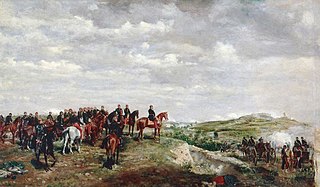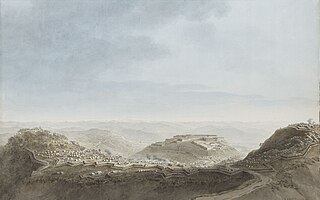
Victor Amadeus III was King of Sardinia and ruler of the Savoyard states from 20 February 1773 to his death in 1796. Although he was politically conservative, he carried out numerous administrative reforms until he declared war on Revolutionary France in 1792. He was the father of the last three mainline Kings of Sardinia.

The Roman Republic was a sister republic of the First French Republic. It was proclaimed on 15 February 1798 after Louis-Alexandre Berthier, a general of the French Revolutionary Army under the rule of Napoleon Bonaparte, had occupied the city of Rome on 10 February. It was led by a Directory of five men and comprised territory conquered from the Papal States. Pope Pius VI was exiled to France and died there in August 1799. The Roman Republic immediately took control of the other two former-papal revolutionary administrations, the Tiberina Republic and the Anconine Republic. The Roman Republic proved short-lived, as Neapolitan troops restored the Papal States in October 1799.

The Second Italian War of Independence, also called the Sardinian War, the Austro-Sardinian War, the Franco-Austrian War, or the Italian War of 1859, was fought by the Second French Empire and the Kingdom of Sardinia against the Austrian Empire in 1859 and played a crucial part in the process of Italian Unification.

The Italian campaigns of the French Revolutionary Wars (1792–1801) were a series of conflicts fought principally in Northern Italy between the French Revolutionary Army and a Coalition of Austria, Russia, Piedmont-Sardinia, and a number of other Italian states.

The Battle of Millesimo, fought on 13 and 14 April 1796, was the name that Napoleon Bonaparte gave in his correspondence to one of a series of small battles that were fought in Liguria, Northern Italy between the armies of France and the allied armies of the Habsburg monarchy and of the Kingdom of Sardinia-Piedmont.

The Subalpine Republic was a short-lived republic that existed between 1800 and 1802 on the territory of Piedmont during its military rule by the French Consulate.

The Battle of Mondovì was fought on 21 April 1796 between the French army of Napoleon Bonaparte and the army of the Kingdom of Sardinia-Piedmont led by Michelangelo Alessandro Colli-Marchi. The French victory meant that they had put the Ligurian Alps behind them, while the plains of Piedmont lay before them. A week later, King Victor Amadeus III sued for peace, taking his kingdom out of the First Coalition. The defeat of their Sardinian ally wrecked the Austrian Habsburg strategy and led to the loss of northwest Italy to the First French Republic.

Giovanni Maria Angioy was a Sardinian politician and patriot and is considered to be a national hero by Sardinian nationalists. Although best known for his political activities, Angioy was a university lecturer, a judge for the Reale Udienza, an entrepreneur and a banker.

Cherasco is a comune (municipality) in the Province of Cuneo in the Italian region Piedmont, located about 50 kilometres (31 mi) southeast of Turin and about 40 kilometres (25 mi) northeast of Cuneo. As of 1-1-2017, it had a population of 9096 and an area of 81.2 square kilometres (31.4 sq mi).

The Flags of Napoleonic Italy were the green, white and red tricolour flags and banners in use in Italy during the Napoleonic era, which lasted from 1796 to 1814. During this period, on 7 January 1797, the green, white and red tricolour was officially adopted for the first time as a national flag by a sovereign Italian state, the Cispadane Republic. This event is commemorated by the Tricolour Day.

The Treaty of Paris of 15 May 1796 was a treaty between the French Republic and the Kingdom of Piedmont-Sardinia during the War of the First Coalition.

In the Battle of Ceva on 16 April 1796, troops of the First French Republic under General Pierre Augereau fought against part of the army of the Kingdom of Sardinia-Piedmont led by General Giuseppe Felice, Count Vital. Augereau assaulted the strong defensive position without success. At the direction of the Sardinian army commander, Feldmarschal-Leutnant Michelangelo Colli, Vital withdrew on the 17th in order to avoid being trapped by a second French division.

The Montenotte campaign began on 10 April 1796 with an action at Voltri and ended with the Armistice of Cherasco on 28 April. In his first army command, Napoleon Bonaparte's French army separated the army of the Kingdom of Sardinia-Piedmont under Michelangelo Alessandro Colli-Marchi from the allied Habsburg army led by Johann Peter Beaulieu. The French defeated both Habsburg and Sardinian armies and forced Sardinia to quit the First Coalition. The campaign formed part of the Wars of the French Revolution. Montenotte Superiore is located at the junction of Strada Provinciale 12 and 41 in the Liguria region of northwest Italy, 15 kilometres (9 mi) northeast of Carcare municipality. However, the fighting occurred in an area from Genoa on the east to Cuneo on the west.

Michelangelo Alessandro Colli-Marchi or Michelangelo da Vigevano or Michael Colli entered the Habsburg Austrian army as a commissioned officer and became a general officer after fighting in the Seven Years' War, War of the Bavarian Succession, and Austro-Turkish War. During the War of the First Coalition, he was loaned to the Kingdom of Sardinia-Piedmont for three years. In 1796, his army was defeated by Napoleon Bonaparte in a swift campaign that knocked Sardinia-Piedmont out of the war. In early 1797, he was given command of the army of the Papal States, but his troops were defeated at Faenza.

The Second Battle of Saorgio was fought from 24 to 28 April 1794 between a French First Republic army commanded by Pierre Jadart Dumerbion and the armies of the Kingdom of Sardinia-Piedmont and the Habsburg monarchy led by Joseph Nikolaus De Vins. It was part of a successful French offensive designed to capture strategic positions in the Maritime Alps and Ligurian Alps, and on the Mediterranean coast. Tactical control of the battle was exercised by André Masséna for the French and Michelangelo Alessandro Colli-Marchi for the Coalition. Saorge is located in France, about 70 kilometres (43 mi) northeast of Nice. At the time of the battle, the town was named Saorgio and belonged to Piedmont.

The Piedmontese Republic was a revolutionary, provisional and internationally unrecognized government established in Turin between 1798 and 1799 on the territory of Piedmont during its military rule by the French First Republic.
The Armistice of Cherasco was a truce signed at Cherasco, Piedmont, on 28 April 1796 between Victor Amadeus III of Sardinia and Napoleon Bonaparte. It withdrew Sardinia from the War of the First Coalition and handed over Alessandria, Coni and Tortone to Republican France. Sardinia also handed over supplies and munitions to France and allowed its troops free passage through Piedmont. It was followed by a full peace treaty signed in Paris the following 15 May, in which Sardinia handed over the county of Nice, the duchy of Savoy, Tende and Beuil to France, as well as guaranteeing free passage through its remaining territory for French troops.

The flag of Piedmont is one of the official symbols of the region of Piedmont in Italy. The current flag was adopted on 24 November 1995.

The Regiment "Nizza Cavalleria" (1st) is a cavalry unit of the Italian Army based in Bellinzago Novarese in Piedmont. The regiment is the reconnaissance unit of the Alpine Brigade "Taurinense".

The Regiment "Genova Cavalleria" (4th) is a cavalry unit of the Italian Army based in Palmanova in Friuli Venezia Giulia. The regiment is the highest decorated and oldest cavalry regiment of the Italian Army and the only army unit, whose anniversary commemorates a pre-Risorgimento event. The regiment is the reconnaissance unit of the Cavalry Brigade "Pozzuolo del Friuli".



















